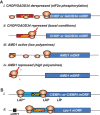Translational regulation by uORFs and start codon selection stringency
- PMID: 37433636
- PMCID: PMC10393191
- DOI: 10.1101/gad.350752.123
Translational regulation by uORFs and start codon selection stringency
Abstract
In addition to the main, protein-coding, open reading frame (mORF), many eukaryotic mRNAs contain upstream ORFs (uORFs) initiated at AUG or near-cognate codons residing 5' of the mORF start site. Whereas translation of uORFs generally represses translation of the mORFs, a subset of uORFs serves as a nexus for regulating translation of the mORF. In this review, we summarize the mechanisms by which uORFs can repress or stimulate mRNA translation, highlight uORF-mediated translational repression involving ribosome queuing, and critically evaluate recently described alternatives to the delayed reinitiation model for uORF-mediated regulation of the GCN4/ATF4 mRNAs.
Keywords: ATF4; GCN4; eIF2 phosphorylation; ribosome queuing; stringency; uORF.
Published by Cold Spring Harbor Laboratory Press.
Figures






Similar articles
-
Genome-wide identification of Arabidopsis non-AUG-initiated upstream ORFs with evolutionarily conserved regulatory sequences that control protein expression levels.Plant Mol Biol. 2023 Jan;111(1-2):37-55. doi: 10.1007/s11103-022-01309-1. Epub 2022 Aug 31. Plant Mol Biol. 2023. PMID: 36044152
-
PRRC2 proteins impact translation initiation by promoting leaky scanning.Nucleic Acids Res. 2023 Apr 24;51(7):3391-3409. doi: 10.1093/nar/gkad135. Nucleic Acids Res. 2023. PMID: 36869665 Free PMC article.
-
Evolutionarily conserved inhibitory uORFs sensitize Hox mRNA translation to start codon selection stringency.Proc Natl Acad Sci U S A. 2022 Mar 1;119(9):e2117226119. doi: 10.1073/pnas.2117226119. Proc Natl Acad Sci U S A. 2022. PMID: 35217614 Free PMC article.
-
Translational Regulation by Upstream Open Reading Frames and Human Diseases.Adv Exp Med Biol. 2019;1157:99-116. doi: 10.1007/978-3-030-19966-1_5. Adv Exp Med Biol. 2019. PMID: 31342439 Review.
-
Does eIF3 promote reinitiation after translation of short upstream ORFs also in mammalian cells?RNA Biol. 2017 Dec 2;14(12):1660-1667. doi: 10.1080/15476286.2017.1353863. Epub 2017 Sep 15. RNA Biol. 2017. PMID: 28745933 Free PMC article. Review.
Cited by
-
Ribosome decision graphs for the representation of eukaryotic RNA translation complexity.Genome Res. 2024 May 15;34(4):530-538. doi: 10.1101/gr.278810.123. Genome Res. 2024. PMID: 38719470 Free PMC article.
-
Understanding the regulation of protein synthesis under stress conditions.Biophys J. 2024 Oct 15;123(20):3627-3639. doi: 10.1016/j.bpj.2024.09.014. Epub 2024 Sep 14. Biophys J. 2024. PMID: 39277792
-
Stem-loop-induced ribosome queuing in the uORF2/ATF4 overlap fine-tunes stress-induced human ATF4 translational control.Cell Rep. 2024 Apr 23;43(4):113976. doi: 10.1016/j.celrep.2024.113976. Epub 2024 Mar 19. Cell Rep. 2024. PMID: 38507410 Free PMC article.
-
MCTS2 and distinct eIF2D roles in uORF-dependent translation regulation revealed by in vitro re-initiation assays.EMBO J. 2025 Feb;44(3):854-876. doi: 10.1038/s44318-024-00347-3. Epub 2025 Jan 2. EMBO J. 2025. PMID: 39748120 Free PMC article.
-
Enhancing the annotation of small ORF-altering variants using MORFEE: introducing MORFEEdb, a comprehensive catalog of SNVs affecting upstream ORFs in human 5'UTRs.NAR Genom Bioinform. 2025 Mar 19;7(1):lqaf017. doi: 10.1093/nargab/lqaf017. eCollection 2025 Mar. NAR Genom Bioinform. 2025. PMID: 40109352 Free PMC article.
References
Publication types
MeSH terms
Substances
LinkOut - more resources
Full Text Sources
